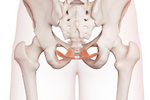Pelvic floor weakness is extremely common. Traditional approaches to pelvic floor strengthening target the function of the muscles through specific exercises such as kegal exercises. While these are helpful as part of an overall strategy, there are other areas that need to function well for the pelvic floor to be effective.
The pelvic floor muscles attach to the inside of the sacrum bone which forms the back of the pelvis. Just like many muscles in your body, the pelvic floor muscles shorten and lengthen. Importantly they do so in sync with our breathing.
When we take a breath in, the diaphragm should lower and the pelvic floor muscles should lengthen and lower to create more space for the abdominal contents and ensure the pressure in the abdominal area doesn’t increase inappropriately. When we breath out, the pelvic floor rises back to its resting position as does the diaphragm muscle. This is what nature has designed our bodies to do, however many people have altered breathing patterns due to stress and other lifestyle factors. The most common breathing fault that we see is where upon breathing in the stomach does not lower and relax but instead is “sucked” in towards the spine. This creates a significant change in the pressure within the abdominal cavity and pelvic floor muscles and over time can lead to pelvic organ prolapses.
When we actively contract our pelvic floor muscles – such as when we are performing exercises such as kegals – we shorten the muscles and the distance between the sacrum and the front of the pelvis (the pubic bone). The muscles that oppose this motion are the glute muscles as they attach to the opposite side of the sacrum and therefore pull the sacrum back away from the pubic bone. Weakness of the glute muscles combined with constant contraction of the pelvic floor muscles leads to the pelvic floor muscles becoming shorter and tighter over time. Unfortunately, when a muscle shortens, it’s ability to generate force reduces and hence the pelvic floor muscles require more effort to contract. This is the reason that many people experience prolapses despite performing their pelvic floor exercises.
Healthy function of the glute muscles and also the diaphragm – in addition to normal breathing patterns – become even more essential when the pelvic floor muscles are under load such as when we are lifting objects, jumping or holding our breath. Under these circumstances, if these two areas are not performing as they should be, the pelvic floor muscles are under a significantly higher amount of strain. These are the most common situations where people experience continence problems.
Focusing on pelvic floor muscle strength alone will help to a point, however incorporating this with strengthening the pelvic and core muscles – especially the glute muscle – and focusing on correct breathing and diaphragm muscle function provide significantly added benefit. Of course even broader than this is considering the importance of simple lifestyle strategies such as reducing overall sitting time and maintaining healthy hip and pelvic mobility which all impact on pelvic floor muscle function.

